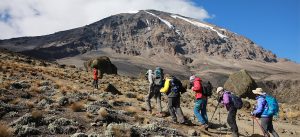Understanding Kilimanjaro Climbing Grade
Kilimanjaro Climbing Grade Overview
Mount Kilimanjaro, located in Tanzania, is the tallest freestanding mountain in the world and a popular destination for climbers seeking an unforgettable adventure. The climbing routes on Kilimanjaro are graded based on their level of difficulty, with each route offering a unique experience for climbers of all skill levels. Understanding the climbing grade of Kilimanjaro routes is essential for selecting the right route that matches your experience, fitness level, and personal preferences.
At Sunset Africa Safari, we offer guided tours to climb Mount Kilimanjaro, providing expert guides, support staff, and equipment to ensure a safe and memorable climbing experience. Our team is dedicated to helping climbers understand the different climbing grades and choose the best route for their Kilimanjaro adventure.
Factors Influencing Climbing Difficulty
Several factors influence the difficulty level of climbing routes on Mount Kilimanjaro, including:
Altitude
One of the most challenging aspects of climbing Mount Kilimanjaro is the high altitude. As climbers ascend the mountain, they may experience symptoms of altitude sickness, such as headaches, nausea, and fatigue. The higher the altitude, the more difficult it becomes to acclimatize to the thin air. Some routes on Kilimanjaro have a more gradual ascent, allowing climbers to acclimatize more effectively and reduce the risk of altitude sickness.
Terrain
The terrain on Mount Kilimanjaro varies from rocky slopes to glaciers, with each route offering a different mix of challenges. Some routes require technical climbing skills, such as using ropes and harnesses, while others are more straightforward and suitable for novice climbers. Understanding the terrain of each route is crucial for selecting a route that matches your comfort level and experience.
Duration
The duration of the climb also influences the difficulty level of Kilimanjaro routes. Some routes can be completed in as little as five days, while others may take up to ten days or more. Longer routes typically allow for better acclimatization and a more gradual ascent, reducing the risk of altitude sickness. However, longer climbs also require greater physical endurance and mental stamina.
Weather
Weather conditions on Mount Kilimanjaro can vary dramatically, with temperatures ranging from hot and humid at lower elevations to freezing cold at the summit. Climbers must be prepared for changing weather conditions, including rain, snow, and high winds. Some routes are more exposed to the elements than others, making them more challenging in adverse weather conditions.
In conclusion, understanding the climbing grade of Mount Kilimanjaro routes is essential for a successful and safe climbing experience. By considering factors such as altitude, terrain, duration, and weather, climbers can choose a route that matches their experience and fitness level. Sunset Africa Safari offers guided tours to climb Mount Kilimanjaro, providing expert support and guidance for climbers of all skill levels. For booking requests, please contact info@sunsetafricasafari.com.


